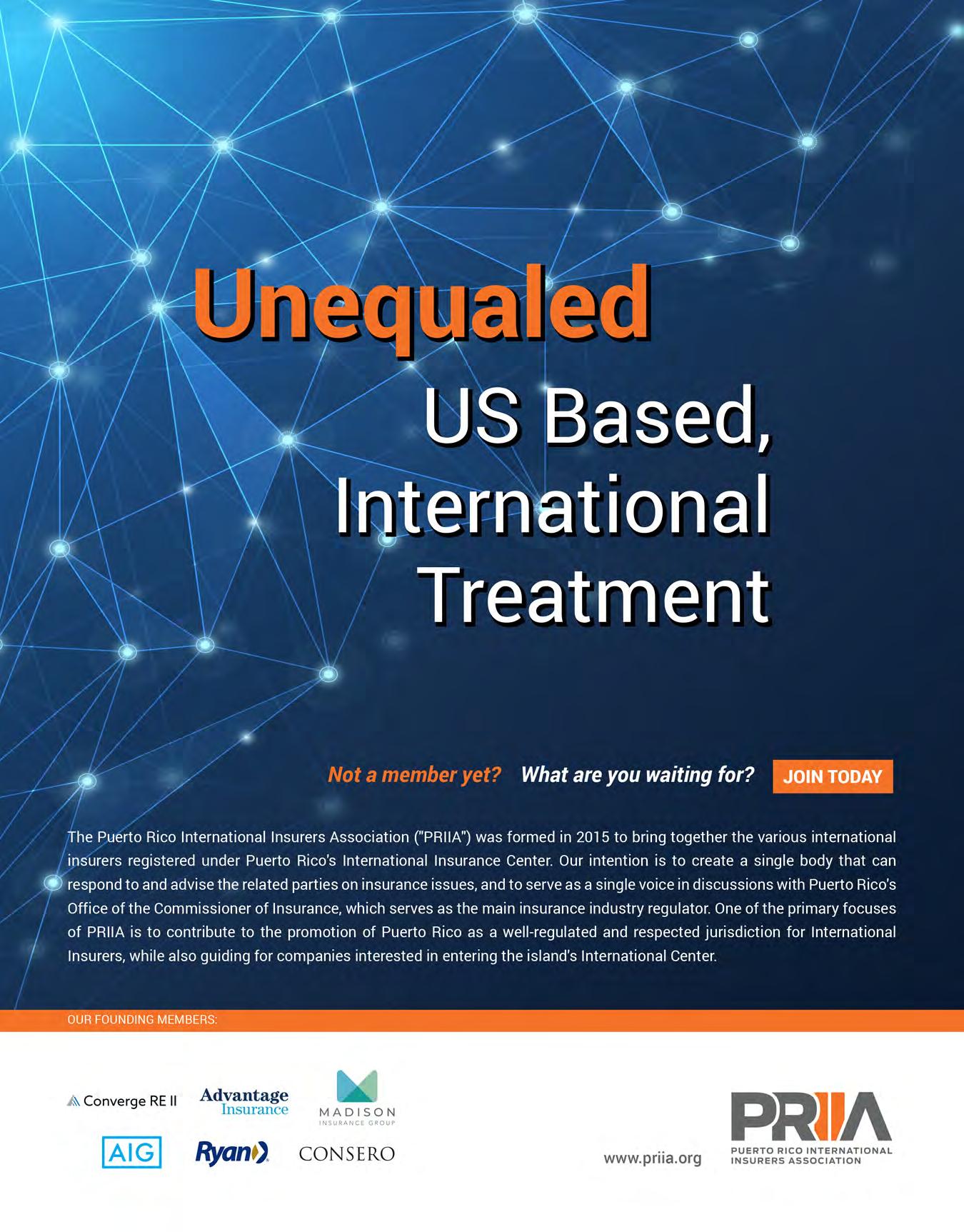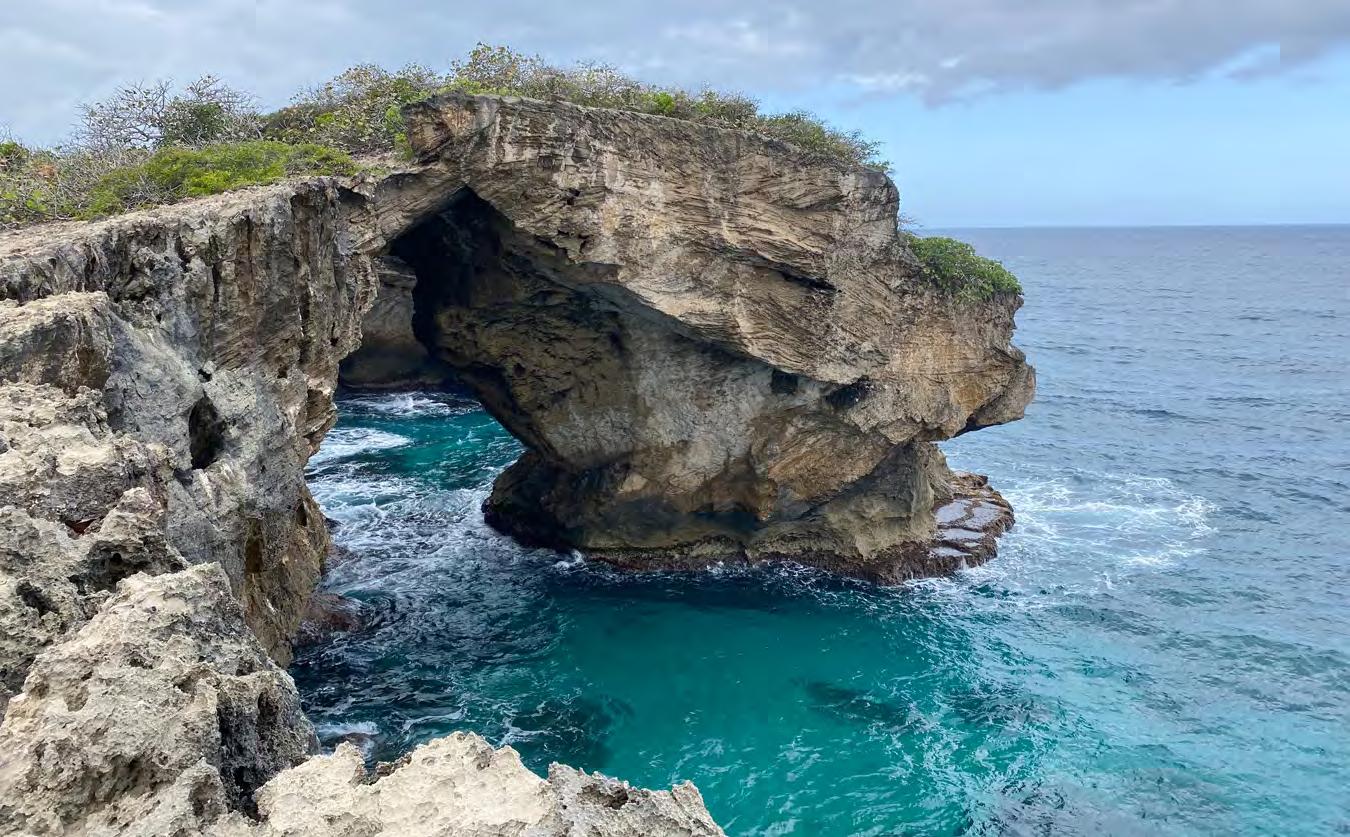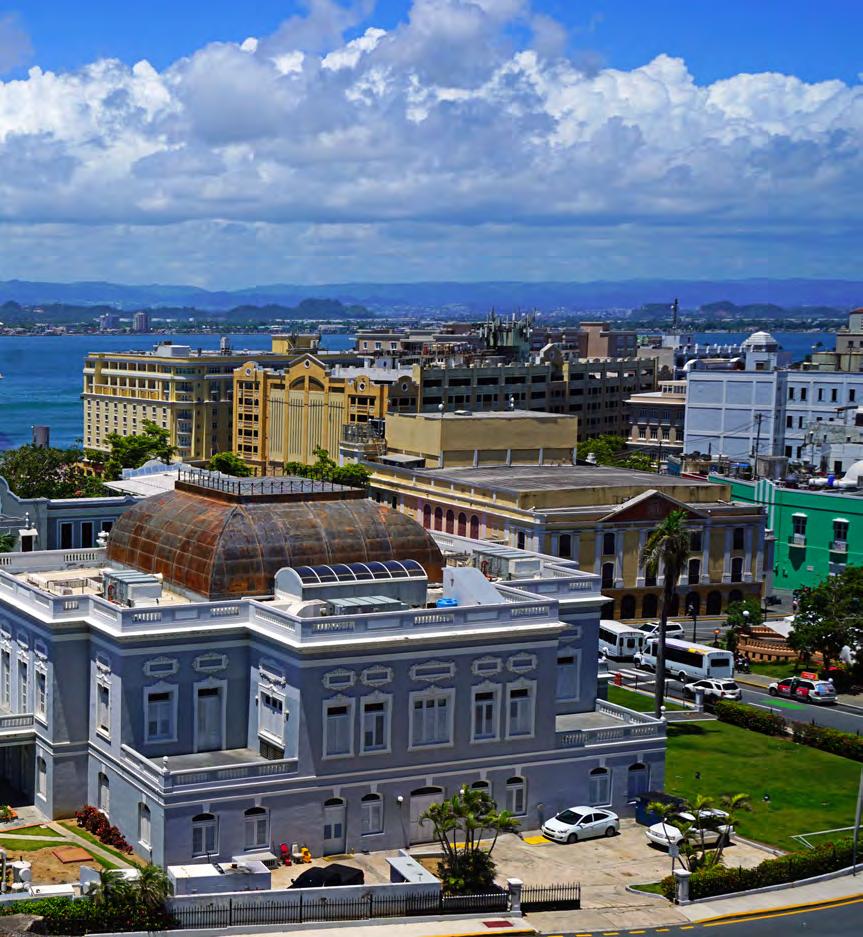



High with Confidence! International Insuranceisourthing. We are your insurance consulting and management firm in San Juan, Puerto Rico. We help entrepreneurs set up successfulinsurance platforms using Puerto Rico as thejurisdiction for growth: providing step-by-step support during initial formation stages, as well as ongoing management and compliance services to lnsurtech startups, international insurers, and reinsurers organized in Puerto Rico. 5 Domingo MarreroSt. Suite4. SanJuan. Puerto Rico 00925 IICG INTERNATIONAL INSURER'S CONSULTING GROUr 305-515-8965 r.gely@iicgpr.com iicgpr.com
Aim
The Puerto RicoInternational Banks Association ("PRIBA") brings together the various InternationalBankingEntities (IBE) andInternationalFinancialEntities (IFE) registered underthePuertoRico's"InternationalBankingCenterRegulatoryAct"or"Law52"and the"InternationalFinancialCenterRegulatoryAct"or"Law273"tocreateasingle body that can respond to and advise the related parties on banking issues and to have a single voice inthe banking industry.


■ Single bodyrepresenting International Banks.
■ Promote Puerto Ricoas anOffshoreJurisdiction.
■ Developeducational programsfor International Banks.
■ Industry representativeinteractionwith goverment andregulators.

admin@priba.net ■ www.priba.net Not a member? JOIN TODAY PUERTO RICO INTERNATIONAL BANKS ASSOCIATION +l (787) 705-8868
Dear PRIIA and PRIBA Members and Friends,
As we release this edition of the Puerto Rico Financial Services Review, it is worth noting that Puerto Rico has a long-standing history as a hub for international insurers and banks. Despite the challenges of 2022, both the Puerto Rico International Insurers Association (PRIIA) and Puerto Rico's International Banks Association (PRIBA) have continued to demonstrate their commitment to best practices and unwavering support for their members.
One of the advantages of operating in Puerto Rico is the favorable tax and regulatory environment for financial services companies. Additionally, Puerto Rico has a highly educated and skilled workforce, with many professionals who are bilingual in English and Spanish. As a US territory, Puerto Rico offers businesses access to the US market without some of the regulatory burdens that can come with operating on the mainland.
However, Puerto Rico is not immune to the challenges faced by the financial services industry globally. In response, the jurisdiction has adapted and evolved, with a renewed focus on compliance and supervision. The Puerto Rico Financial Institutions Commissioner's Office (OCIF) has increased its monitoring and examination of financial institutions, with a particular emphasis on anti-money laundering and know-your-customer (AML/KYC) regulations.
Fintech and insurtech companies are also finding value in Puerto Rico, with the jurisdiction positioning itself as an innovation hub for financial technology. For example, the Puerto Rico Science, Technology, and Research Trust recently launched a program to support the development of fintech startups on the island.
In this edition, we feature interviews with Hugo Cordova, President of PRIIA, and Eduardo Colon, President of PRIBA, who discuss the challenges their organizations face and potential avenues for growth. Our articles offer valuable insights into how Puerto Rico perseveres despite obstacles, with service providers highlighted throughout this edition demonstrating exceptional performance.
For those considering Puerto Rico as a business jurisdiction, it is essential to understand that adherence to all local, federal, and international regulations is vital for the development of our jurisdiction. PRIIA and PRIBA consistently emphasize the significance of maintaining robust governance, AML/KYC procedures, collaboration with legal and tax advisors, ongoing management training, and independent testing across their membership.
As we look ahead to the Financial Services Forum 2023, we remain optimistic about Puerto Rico's trajectory as a jurisdiction for international insurers and banks. The island has a rich history in the financial services industry, and with the right approach to compliance and innovation, it can continue to be a leader in this space.
Sincerely
A.
RUBÉN A. GELY | EDITOR-IN-CHIEF
JORGE I. RODRÍGUEZ | ART DIRECTOR
MARIMAR PÉREZ-RIERA | Executive Director
Puerto Rico International Insurers Association
Puerto Rico International Banks Association
HUGO CÓRDOVA | President of PRIIA
Head of Business Development
Advantage Insurance Services, LLC
RUBÉN A. GELY | Vice President of PRIIA
President
International Insurer Consulting Group, Inc.
DAVID KIRKUP | CFO & COO
Madison Insurance Group
Board Member of PRIIA Board of Directors
KEN KOTCH | Principal
Ryan, LLC
Board Member of PRIIA Board of Directors
ERICK NEGRÓN | Special Counsel
Rexach & Pico
Board Member of PRIIA Board of Directors
ANTONIO RAMÍREZ | Capital Member
McConnell Valdés, LLC.
Board Member of PRIIA Board of Directors
PEDRO VIDAL | Capital Member
Vidal, Nieves & Bauza, LLC.
Board Member of PRIIA and PRIBA Board of Directors
EDUARDO COLÓN | President of PRIBA
President
Advantage International Bank Corp.
CLEMENTINA PERAZA | Executive Vice President
BNC International Banking Corp.
Board Member of PRIBA Board of Directors
ROGELIO CARDOZO | CEO
ItalBank International, Inc.
Board Member of PRIBA Board of Directors
ROGER DUERIG | Director and CEO
Tolomeo Bank International, Corp.
Board Member of PRIBA Board of Directors
ALEXANDER J. SILVER | Managing Director
Stern International Bank LLC
Board Member of PRIBA Board of Directors
ENGELBERT RODRÍGUEZ | President and CEO

Bancaribe International Bank, Inc.
Board Member of PRIBA Board of Directors
editor by mail or email: 250 Munoz Rivera Avenue
Suite 710 San Juan PR 00918 info@priia.org | info@priba.net
The Puerto Rico Financial Services Review is published annually on behalf of the Puerto Rico International Insurers Association (PRIIA) and the Puerto Rico International Banks Association (PRIBA). The views and opinions expressed by our contributors in the articles reflect the author(s) opinions and do not necessarily reflect those of the publisher or editor. PRIIA and PRIBA cannot guarantee the accuracy, completeness, or reliability of the information provided in this publication, and are not responsible for any inaccuracies, omissions, or misrepresentations. Additionally, PRIIA and PRIBA cannot accept liability for any loss or damage caused by the publication or the advertising content. All material in this publication is strictly copyrighted, and no part may be reproduced or used without written consent from the publisher. For more information on obtaining permission to use the material, please contact the publisher.
2023 PUERTO RICO FINANCIAL SERVICES REVIEW | 5 PRFSR | Foreword
Published
©
All rights reserved
in Puerto Rico. All
the
by PRIIA | PRIBA www.priia.org • www.priba.net
2023
Printed
inquiries to
AIP
Ruben
Gely-Ortiz is the President of International Insurers Consulting Group, and Vice President for the Puerto Rico International Insurers Association. He specializes in off-shore protected cell business and international reinsurance arrangements.






II a •
captive insurer is a wholly owned subsidiary of the parent business formed primarily for the purpose of insuring or reinsuring the risk of its parent business owners. The formation and operation of a captive insurer has various key considerations, regulatory requirements, and associated costs for prospective owners, but if structured correctly for a suitable candidate, the inclusion of a captive insurance program should benefit the overall business model.
BENEFITS
Key benefits associated with a captive structure include:
• Capturing underwriting profits
• Improved risk management
• Develop tailor-made coverage
• Greater flexibility
• Access to reinsurance markets
• Investment income
CAPTURING UNDERWRITING PROFITS
By capturing underwriting profits otherwise lost under a commercial insurance transaction, a business can improve its consolidated bottom line.
A CAPTIVATING INTRODUCTION
BUSINESSES DESIRING MORE CONTROL AND FLEXIBILITY OVER THEIR INSURANCE PROGRAMS OFTEN SEEK ALTERNATIVE RISK TRANSFER PROGRAMS AS AN OPTION TO THE COMMERCIAL INSURANCE MARKET. A CAPTIVE INSURER IS ONE OF THE ALTERNATIVE SOLUTIONS OFTEN UTILIZED.
IMPROVED RISK MANAGEMENT
With a shift in control from an external third-party commercial insurer to internal oversight, a business is more incentivized to implement robust risk management procedures to reduce the potential for loss events, review actual claims with circumspection, and maintain detailed historical records leading to better risk management outcomes including lower claims costs.
DEVELOP TAILOR-MADE COVERAGE
Captive insurance policies can be specifically tailored to address unique risk areas of the business, close gaps in existing commercial insurance policies and include coverage not available in the commercial market.

GREATER FLEXIBILITY
The captive owner is in control of decisions and can use the captive strategically to adapt to cyclical and environmental changes as well as changes in the business itself.
ACCESS TO REINSURANCE MARKETS
By: Claire Hutchinson CA(SA), CFA. | April 2023
The captive structure creates an opportunity to access reinsurance markets that would otherwise be unavailable.
INVESTMENT INCOME
Capital surplus and accumulated profits can be invested to generate additional income to improve ongoing profitability and fund claims as and when they arise.
KEY CONSIDERATIONS
A captive insurer must meet specific criteria to be classified as an insurance company and ensure it upholds the primary purpose of protecting the insured parties, operates effectively and maintains the industry’s integrity.
JURISDICTION
The necessity for legislation, local regulatory authority, and formalized protocol is driven by the inherent risk insurance companies and captives carry. There are several jurisdictions with respected, active captive industries to choose from, all with their own unique legal and regulatory framework.
2023 PUERTO RICO FINANCIAL SERVICES REVIEW | 7 Advantage Insurance | PRFSR
Prospective captive owners should carefully consider the goals and objectives of the captive when selecting a jurisdiction. A captive will achieve optimal performance in a jurisdiction where the insurance coverage and structure are aligned with the specialization of that individual jurisdiction. The elected domicile should also be proportionate to the nature, size, and complexity of the captive; for example, a large risk retention group would require a domicile with robust regulation to govern the structural complexities.
A regulator with a reputation for providing innovative, flexible, and dynamic framework along with the support of a proven track record are also primary driving factors when considering domicile options.
For participants seeking to benefit from the advantages that the Puerto Rico International Insurers Association has to offer, there is an existing and growing captive market in Puerto Rico. The jurisdiction holds the unique position of being integrated into the infrastructure of the United States through association as a territory while maintaining connections to Latin America.
CAPITAL AND SOLVENCY
Captive Insurers are required to maintain a minimum level of capital and solvency as a risk measure to ensure that the company can withstand future losses; the higher the risk profile, the higher the level of capital required. Each jurisdiction will prescribe its own minimum level of capital per license for a captive to be eligible for an insurance license.
The minimum capital requirements across various jurisdictions have been summarized in “Table 1A”.
It must be noted that many jurisdictions have additional requirements over and above the
minimum base level, which is determined as a percentage of the premium in the captive.
OTHER CONSIDERATIONS
Another key consideration when analyzing captive suitability for a business is the related costs. These can include formation costs, licensing fees, and operational fees - such as audit fees, insurance management fees, and actuarial fees, all of which vary depending on the domicile.
Tax implications in the insured’s domicile and that of the captives should be assessed. Some domiciles provide tax deductions for a premium payment. Some offshore domiciles tax companies at lower rates than that of the insured’s domicile which leads to profits accumulation with a lower overall tax cost.
GETTING STARTED
The captive industry is vast and complex. The best starting point is to engage and partner with insurance professionals in the jurisdiction of choice who have the required industry experience to navigate and advise on the formation process. Insurance professionals that typically form part of the captive team include insurance managers, legal counsel, actuaries, investment managers, and brokers.
The captive formation will require critical information to initiate the application process. An essential, non-exhaustive startup check-list may include the following:
• Robust feasibility study to understand the overall business environment, identification of precise areas of direct or indirect risk exposure, and the quantification of risks in underwriting and actuarial models;
• Historical loss data to tailor policies according to needs and objectives;
• Proposed structure of insurance program, including consideration of fronting/ceding arrangement and security requirements.
• Pro forma financial projections for 1-5 years;
• Capital and solvency requirements;
• Ownership structure and corporate governance practices;
• Investment policy statement.
FINAL THOUGHTS
Insurance is an essential consideration for any business. Captive structures provide an alternative, sustainable, long-term solution to the commercial insurance market.
It would be worthwhile for a business with financial resources and risk tolerance to at least consider the inclusion of a captive within its existing business model and engage with insurance professionals to develop a proactive action plan.
As an insurance manager with over 25 years of experience and offices located in the UnitedStates, Puerto Rico, and the Cayman Islands, Advantage Insurance has a team of professionals on hand to start you on your captive journey.
Claire Hutchinson is a qualified accountant being a member of the South African Institute of Chartered Accountants and Cayman Islands Institute of Professional Accountants, and is a CFA charter holder. Her work experience includes banking, hedge funds, and captives domiciled in Puerto Rico and the Cayman Islands.
For more informtion on this article email Claire Hutchinson at c.Hutchinson@aimcl.Com.Ky
MINIMUM CAPITAL REQUIREMENTS ACROSS JURISDICTIONS (Table 1A)
Class B (i)$100,000 Class 1$120,000 Class 1$500,000 Pure$250,000 Pure$250,000 Class B (ii)$150,000 Class 2$250,000 Class 2$750,000 Branch Captive$250,000 Industrial Insured$500,000 Class B (iii)$200,000 Class 3/3A/3B - $1,000,000 Class 3$1,500,000 Association$750,000 Association$500,000 Sponsored$1,000,000 Sponsored$500,000 RRG$500,000 RRG$1,000,000
Capitalization Cayman IslandsBermudaPuerto RicoUSA - S.
DOMICILE
CarolinaUSA - Vermont
8 | 2023 PUERTO RICO FINANCIAL SERVICES REVIEW PRFSR | Advantage Insurance
A CAPTIVE WILL ACHIEVE OPTIMAL PERFORMANCE IN A JURISDICTION WHERE THE INSURANCE COVERAGE AND STRUCTURE ARE ALIGNED WITH THE SPECIALIZATION OF THAT INDIVIDUAL JURISDICTION.

2023 PUERTO RICO FINANCIAL SERVICES REVIEW | 9 Advantage Insurance | PRFSR
It's a new era in Puerto Rico.
We are emerging as a business and investment destination, and the world is seeing us in a new light.

We are home to those who see opportunities where others can't. The innovators, the idealists, the futurists. Those who know that to change the world one must challenge conventions.
Our island is the birthplace of a new global class of creators and entrepreneurs. Invest Puerto Rico is tasked with attracting investment and new businesses to this growing ecosystem, that will contribute to sustainable economic development.
Puerto Rico is ready to welcome you. Our proposal: world-class human capital, a mature and collaborative business community, business-friendly policy, developing infrastructure, and a shared vision of the future.

The rules have changed. Those who create the future get the unique advantage that Puerto Rico offers as their base for generating value and developing new ideas.
For those leading the way forward, our doors are open.
Game-Changers, welcomehome.
Learn more at investpr.org

0 ci +-' en (lJ > C • ········h···· ••••• . ........ ..... ..... ·new· · ollle · . .. .. . . . . . ... .. . . •.
.... § ' ; invest PUERTO RICO

A Primer on International Insurer Holding Companies
LEGISLATION FOR ESTABLISHING PUERTO RICO’S INCOME TAX EXEMPT INSURER HOLDING COMPANIES.
By: Erick G. Negrón Rivera | April 2023
n interesting but sometimes overlooked feature of the Puerto Rico international insurers legislation is that which relates to the possibility of establishing for such insurers holding companies that will be fully exempt from Puerto Rico income taxes if properly organized. Indeed, the provisions of Chapter 61 of the Insurance Code, aside from establishing the regulatory framework applicable to international insurers, also allow for the creation of “international insurer holding companies” (also known as “Chapter 61 holding companies”).
These are essentially defined as legal entities organized under Puerto Rico law that own stock shares or other securities issued by international insurers, and that may also own other specified types of assets, virtually anywhere in the world. These holding companies are fully exempt from Puerto Rico taxation on their annual net income, and their dividends and similar distributions paid out are fully tax-exempt as well.
They are also fully exempt from municipal license taxes and municipal property taxes if the underlying international insurer became
organized prior to the relevant date of effectiveness of Act No. 60 of 2019; Chapter 61 holding companies of international insurers subsequently organized are only partially exempt from these (relatively modest) municipal taxes.

In a nutshell, aside from owning stock shares or other securities issued by Puerto Rico international insurers, a Chapter 61 holding company may own an unlimited amount of stock or securities issued by other insurers, and an unlimited amount of securities or assets necessary for the operation of businesses incidental to the insurance business, as well as a limited amount of certain other assets.
It may also own cash, cash equivalents and “investment portfolios” (as defined by regulation) in an amount that does not exceed, on a 1:1 basis, the value of its other permitted assets.
Thus, for example, a Chapter 61 holding company that owns stock shares of a Puerto Rico international insurer that are worth $10 million, and stock shares of a Canadian insurer that are worth $20 million, may also own as much as $30 million in U.S. publicly traded securities; all of
this in accordance with the valuation methods and other norms established in Article 61.040 of the Insurance Code and Rule 82 of the Office of the Commissioner of Insurance.
As earlier said, the income derived by the Chapter 61 holding company from the ownership of any such assets (be it, for instance, through dividends, interest or capital gains) is fully exempt from Puerto Rico income taxes, and any dividends or equivalent distributions it pays out are similarly exempt from income tax (or from tax withholding obligations). Interest paid out by the Chapter 61 holding company to nonresident individuals or to foreign (i.e., non-Puerto Rico) corporations and partnerships not engaged in a trade or business in Puerto Rico is also fully exempt from income taxes (and from any tax withholding obligations).
Importantly, Chapter 61 holding companies generally may not “control” Puerto Rico domestic insurers or other Puerto Rico entities that are neither international insurers nor Chapter 61 holding companies (for instance, by owning at least 5% of the voting stock of such entities), although they may control Puerto Rico entities
Erick G. Negrón is a Partner at Rexach & Picó Law Firm focusing on Insurance Regulatory matters, and a Board Member of the Puerto Rico International Insurers Association.
12 | 2023 PUERTO RICO FINANCIAL SERVICES REVIEW PRFSR | Rexach & Picó
A CHAPTER 61 HOLDING COMPANY THAT OWNS STOCK SHARES OF A PUERTO RICO INTERNATIONAL INSURER THAT ARE WORTH $10 MILLION, AND STOCK SHARES OF A CANADIAN INSURER THAT ARE WORTH $20 MILLION, MAY ALSO OWN AS MUCH AS $30 MILLION IN U.S. PUBLICLY TRADED SECURITIES.

2023 PUERTO RICO FINANCIAL SERVICES REVIEW | 13 Rexach & Picó | PRFSR
providing services exclusively to affiliated international insurers. (As an exception, the Commissioner of Insurance may allow the Chapter 61 holding company to control such Puerto Rico entities, provided that any income derived therefrom will not be subject to the tax exemptions allowed to the international insurer and the Chapter 61 holding company.)
While international insurers and their Chapter 61 holding companies used to be fully exempt from municipal license taxes and property taxes, this has changed for new insurers and their Chapter 61 holding companies following the adoption of Act No. 60 of 2019.

Essentially, insurers that filed their application for a certificate of authority at the Office of the Commissioner of Insurance after December 31, 2019 are only 50% exempt from municipal
license (patente) taxes, and 75% exempt from municipal property taxes; similar 50% and 75% exemptions apply to the Chapter 61 holding companies of those international insurers (although the underlying regular rates of municipal license tax may be different for both types of entities—the international insurer and the Chapter 61 holding company).
The above-described tax incentives applicable to Chapter 61 holding companies, like the tax incentives applicable to the underlying international insurers, are guaranteed under tax-incentives grants that are issued by the Department of Economic Development and Commerce of Puerto Rico, following the corresponding application process that is now governed by the afore-mentioned Act No. 60. Those grants, which have a 15-year duration period (and, subject to conditions, may be renewed for an
additional 15-year period), are considered as a contract between the Government of Puerto Rico and the grant beneficiaries, and thus their terms cannot be unilaterally changed by the government.
In the past, investors have found the Chapter 61 holding company provisions to be a highly convenient feature for corporate or tax planning purposes. As the Puerto Rico international insurers platform continues to evolve, this feature may acquire further relevance as a vehicle for the ownership of insurance-related entities and investment assets not only in Puerto Rico but abroad.
For more information about this article contact Atty. Erick G. Negrón at negron@rexachpico.com. Rexach & Picó is located at 802 Manuel Fernández Juncos Ave. in San Juan, Puerto Rico.
14 | 2023 PUERTO RICO FINANCIAL SERVICES REVIEW PRFSR | Rexach & Picó
s a result of the pressure exerted upon governments throughout the world to address the impact of climate change, and its risks, rising activism by stakeholders, a growing call for greater transparency, and the adoption of clear business ethics on the part of companies offering goods and services everywhere, the need to pay attention and incorporate ESG principles in the conduct of business is here to stay.
In consequence, many businesses, including insurance companies, are focusing on the guiding principles behind ESG and taking concrete governance actions directed both, at voluntarily meeting their ESG goals, and objectives as a part of their overall strategy and values, as well as responding to the increasing number of laws and regulations which are being adopted in this area.
For example, in August, 2022, the European Commission’s (EC) regulations requiring that European insurers and reinsurers incorporate sustainability risks as part of their governance polices took effect. The EC regulations in question, --Commission Delegated Regulations
(EU) 2021/1256 and 2021/1257--, amend the EU’s Solvency II framework, and are consistent the EU’s goal of prioritizing sustainability considerations within the financial systems generally. The EC regulations require regulated entities in insurance to consider and account for sustainability risk and factors across several key areas which potentially impact the operational results of insurance companies.

THE REGULATIONS DEFINE “SUSTAINABILITY RISKS” AS ENVIRONMENTAL, SOCIAL AND GOVERNANCE EVENTS OR CONDITIONS THAT, IN IF OCCURRENCE, COULD CAUSE AND ACTUAL OR POTENTIAL IMPACT ON THE VALUE OF THE INVESTMENT OR ON THE VALUE OF THE LIABILITY.
The regulations add a new definition for “sustainability factors” which is centered of environmental, social and employee matters, respect for human rights, anti-corruption and anti-bribery matters.
Some of the more salient changes introduced by the EC regulations include the need for insurers and reinsurers to specifically incorporate
By: Pedro I. Vidal Cordero | April
sustainability risks as a part of their general risk management policies’ framework. Therefore, insurer and reinsurer’s reserves and underwriting policies must now consider the risk of loss or of an adverse change in the value of their insurance obligations resulting from, among other risks, sustainability risks. They also include the need to consider sustainability risks as part of any actuarial opinion issued with respect to an insurer.
Further, the investment policies of insurers and reinsurers must now account for, evaluate and manage sustainability risks identified in their respective investment portfolios. In addition, regulated insurers will also now need to take into account the so-called “sustainability preference” of their clients in respect to the products offered to such clients.
Insurers and reinsurers will need to take into consideration environmental and climate risks as a part of the overall process through which investments are managed by such regulated entities, generally. In doing so, they are required to consider sustainability risks following the principle of the prudent person or investor.
2023
Attorney Pedro I. Vidal Cordero is a Partner at the Vidal, Nieves & Bauzá law firm and he has significant experience in insurance regulatory, transactional and compliance matters.
ESG principles, climate-related risk and the insurance industry in Puerto Rico.
Environmental, Social and Governance principles (”ESG”) have been more than just a simple buzz phrase for business entities and their governing boards during recent times.
Vidal, Nieves & Bauzá | PRFSR 2023 PUERTO RICO FINANCIAL SERVICES REVIEW | 15
In the United States, the Financial Stability Oversight Council (“FSOC”) was established in 2010 pursuant to the “Dodds-Frank Act” to monitor the safety and mitigate the risks to the U.S. financial system, including climate-related financial risk. Its counterpart at the international level is the Financial Stability Board (“FSB”), an international body established in 2009 whose membership primarily consists of the G20 countries, including the United States, and is responsible for promoting global financial stability and making recommendations to strengthen the international financial system.
In 2015 the FSB established the Task Force on Climate-related Financial Disclosures (“TCFD”) in order to develop voluntary recommendations for climate-related disclosures for businesses that could assist different stakeholders, including governments, lenders, insurers and investors, to improve their understanding and analysis of climate-related risks as part of the efforts to transition towards a low-carbon economy. Two years later, the TCFD released final recommendations for climate-related financial disclosures.
The disclosures developed by the TCFD are centered on climate-related risks and opportunities confronted by companies and other organizations, wherever they do business, in the following four core areas: governance, strategy, management of risks, and metrics and targets. Through the recommended types of financial disclosures, 11 in total, the different stakeholders are provided relevant information to understand how a disclosing company evaluates and manages its climate-related risks and opportunities.
In its 2021 Report on Climate-Related Financial Risk, the FSOC acknowledged the problems resulting from the absence of common climate-related disclosure standards for compa nies and financial entities among U.S. regulators. It similarly recognized that the TCFD disclosure framework had gained widespread adoption internationally and was also the leading structure followed by many companies in the United States. In an effort to address the lack of common climate-related disclosures by U.S. companies, in its report the FSOC recommended that its members consider enhancing public reporting requirements for climate-related risks in a manner that builds on the four core elements of the TCFD.
The FSOC has ten voting members which include the heads of each of the main financial regulators in the U.S., and five non-voting members. One of the non-voting FSOC members is a state insurance commissioner who is elected by the Executive Committee of the National Association of Insurance Commissioners (“NAIC”).
In response to the 2021 FSOC recommendation to financial services regulators to adopt the climate-related disclosures recommended by the TCFD in March, 2022, the NAIC Climate and Resiliency (EX)Task Force and its Climate Risk Disclosure Workstream revised the NAIC’s 2010
Climate Risk Disclosure Survey following the recommendations made by the FSOC to conform their climate-risk disclosures to those of the TCFD.
At that time in 2021 when the NAIC Climate Disclosure Survey was updated based on the TCFD framework, fifteen (15) U.S. jurisdictions had been receiving climate-related risk disclosures from their insurers. Companies responding to the NAIC survey were only those having annual written premiums nationwide of $100 million or more. The NAIC initiative was adminis tered through the California Department of Insurance.
The deadline established by the NAIC for responding to the climate-related risk survey was August 31st of each year. In light of the updated 2021 survey conforming to the TCFD framework, the NAIC provided insurers with several alternative dates for their year 2022

response. In the case of companies who had never completed a TCFD-based survey voluntarily, the deadline was moved to November 30, 2022, and, for subsequent years, would revert to the August 31st deadline.
The latter notwithstanding, the NAIC also noted that companies who had never responded to a climate-related risk survey should be given until 2023 (August 31) to respond for the first time to the survey. Companies were encouraged to provide their “best efforts” in replying to each survey question as honestly and completely as possible. All survey responses are considered public, and insurance companies were alerted by the NAIC that they should not include information they considered confidential in survey responses.
Puerto Rico has been a member in good-standing of the NAIC for years. Therefore, it participates in the U.S. state-based system for the
16 | 2023 PUERTO RICO FINANCIAL SERVICES REVIEW PRFSR | Vidal, Nieves & Bauzá
regulation of the insurance business and its industry. In 2012 it became the first U.S. territory to become accredited under the NAIC’s Accreditation Program. It subsequently loss the accreditation in 2021 and, regained it back in December, 2022.
Puerto Rico had not required Puerto Rico’s domiciled insurers from completing and filing the NAIC climate-related risk survey. However, shortly after the NAIC updated its climate-related risk disclosure survey (March, 2022), the Office of the Commissioner of Insurance in Puerto Rico issued a June 9, 2022 ruling letter addressed to insurers and health maintenance organizations domiciled in Puerto Rico with written premiums of $100 million or more to file the updated NAIC climate-related risk survey by November 30, 2022. The current year’s survey is due on August 31, 2023. Companies not meeting the $100 million written premium threshold have been encouraged to file the survey on a voluntary
basis in order identify climate-related risks as a special risk factor in their operations and to improve their best practices towards sustainability.
As indicated above, the TCFD survey, now also followed by the NAIC, focuses on the four core areas of climate-related risk disclosures in an organization´s governance, strategy, risk management and metrics and targets. Based on the TCFD´s implementation recommendations, --which the NAIC recommends insurance companies follow in preparing and responding the NAIC climate-related risk survey--, the TCFD provides guidance with respect to the responses to the required disclosures in each of the four core areas.
This guidance is provided for all industry sectors which provide disclosures under the survey, and also covers specific supplemental guidance directed at the four major industries in the
financial sector, namely, banks, insurance companies, asset managers and asset owners such as pension plans, endowments, foundations and others. The objective behind the disclosures by insurance companies is to allow key stakeholders to better understand how insurers are evaluating and managing climate-related risks in the underwriting and investments. Therefore, governance disclosures are centered on how intensely an insurer´s board of directors and its management focus on climate-related issues, and whether they incorporate climate-related risks issues in their decision-making policies in the organization.
With respect to strategy disclosures, insurance companies should focus on the impacts of climate-related risks and opportunities of climate-related issues in the organization´s short, medium and long-term strategy and on its assets and financial condition. Insurance companies should also consider including

Vidal, Nieves & Bauzá | PRFSR 2023 PUERTO RICO FINANCIAL SERVICES REVIEW | 17
INSURERS AND REINSURERS WILL NEED TO TAKE INTO CONSIDERATION ENVIRONMENTAL AND CLIMATE RISKS AS A PART OF THE OVERALL PROCESS THROUGH WHICH INVESTMENTS ARE MANAGED BY SUCH REGULATED ENTITIES.

18 | 2023 PUERTO RICO FINANCIAL SERVICES REVIEW PRFSR | Vidal, Nieves & Bauzá
responses centered on how climate-risks impact client selection, product development and business activities by sector and geography. The area of risk management addresses the identification, assessment and management of climate-related risks within the insurance company, including their significance when compared to other risks in the organization´s operations.
Finally, with respect to metrics and targets insurers are asked to provide key metrics used to manage climate-related risks. Property Insurers, in turn, should disclose aggregated risk exposure to weather-related catastrophes, among other metrics and targets related to weather considerations, greenhouse gas emissions, water and energy usage, among others.
In conclusion, ESG principles, including climate-
related risk disclosures and others are here to stay. Insurance companies, whose core traditional business has been centered on quantifying and managing risks, generally, are particularly well-positioned to understand and respond to the underlying criteria behind ESG principles and the overall focus on values centered on sustainability. As the United Nations Environmental Program on Principles for Sustainable Insurance Initiative indicates, the insurance industry’s role in this area is centered on three main components.
THE ROLE OF A RISK MANAGER, OR BETTER UNDERSTANDING ENVIRONMENTAL AND SOCIAL RISKS today, and, as a result, in preventing and reducing losses now and in the immediate future.

THE ROLE OF ISSUING INSURANCE PRODUCTS
IN THE MARKETPLACE THAT ARE RESPONSIVE TO THE RISK SUSTAINABILITY FRAMEWORK and its manifestation in the needs faced by actual and potential insureds and communities, in general.
THE ROLE FOR THE INSURANCE INDUSTRY IDENTIFIED UNDER THESE U.N. PRINCIPLES IS THAT OF INSURANCE COMPANIES AS THE INVESTORS AND MANAGERS OF SIGNIFICANT ASSETS WHICH INCREASINGLY WILL TAKE THE FORM OF SUSTAINABLE ASSETS, both in response to third- party pressures and to the risk management policies adopted internally by companies.
For more information about this article contact Pedro I. Vidal, Esq. at pvidal@vnblegal.com or visit www.vnblegal.com. Vidal, Nieves & Bauzá is located at Suite 110, T-Mobile Center.
2023 PUERTO RICO FINANCIAL SERVICES REVIEW | 19 Vidal, Nieves & Bauzá | PRFSR





Helpingfamiliessecure brighterfutures. Medical Insurance Life Insurance Income Protection Savings Plans Rated ''A- Excellent"byAMBest. Products soldthroughMWG International. • INTERNATIONAL A division ofMorgan White Group 75ValenciaAvenue, Suite 801 CoralGables, FL33134 www.morganwhiteintl.com AmFirstLife INSURANCE COMPANY I.I. B7 Tabonuco Street, Suite 1108, Guaynabo, Puerto Rico 00968 WWW.AMFIRSTLIFE.COM
OCTOBER 23 & 24, 2023 SAN JUAN, PUERTO RICO
After a successful meet of the top leaders in internationalinsurance and international banking, planning is already underway for this year's conference. Don't miss out on this once a year event, that will bring together top speakers, plus recent and trending topics.
• Alternative investment management

• Captive Insurance
• Cryptocurrency exchanges and custodians

• International life insurance
• Mortgage servicing
• BSA-AMLCompliance
• Trade finance
For more information, or registering for updates, please visit: financialservicesforumpr.com


PUERTO RICO INTERNATIONAL INSU11E�S ASSOCIATION PUERTO RICO INTERNATIONALBANKS ASSOCIATION
Private Placement in 2023:
An Overview and Benefits Analysis of Puerto Rico Issued International PPVA and PPLI.
By: James A. Walker, Jr. and Andrew R. Erskine | April 2023
or sophisticated, international investors, incorporating a Private Placement Deferred Variable Annuity (“PPVA”) contract or Private Placement Variable Life Insurance (“PPLI”) policy as part of a broader wealth plan can generate unique tax and reporting benefits, especially when issued by a Puerto Rico International Insurer.
In this article, we aim to provide advisors with an introduction to private placement — a small piece of the multi-trillion dollar global insurance industry — by outlining the structural differences, mathematical benefits, and practical considerations of PPVA and PPLI and by illustrating when and how to use each product to address common needs of modern domestic and foreign clients. Further, we address the added benefits of private placement issued by a Puerto Rico International Insurer as compared to that issued by domestic carriers.
PRIVATE PLACEMENT: A REFRESHER
PPVA contracts and PPLI policies are highly bespoke, variable insurance products offered by international and domestic U.S. insurance
companies that can offer lower costs and greater policy customization than traditional “retail” variable annuities and life insurance. Additionally, when structured appropriately, these products can provide unique, critical benefits to modern ultra-high net worth (“UHNW”) individuals and family offices, including income and estate tax optimization, statutory asset protection, underlying investment flexibility, significantly decreased reporting requirements, and greater confidentiality of sensitive information not offered by alternative insurance and investment products.
In practice, advisors can include new or existing investments in hedge funds, private equity, and other tax-inefficient asset classes inside a PPVA or PPLI policy, deferring or completely mitigating associated annual taxes for their client while retaining managerial control of the underlying investments.

Private placement policies and contracts are sold to a limited number of accredited investors that are represented by their own tax, accounting, legal, and financial advisors and are considered “variable” because policy cash value is tied to
gains or losses on underlying investments rather than to a guaranteed investment return. While the private placement market has traditionally been focused on United States citizens and residents, more recently the potential tax, reporting, asset protection, and other benefits of these bespoke insurance products for clients with minimal or no active U.S. tax exposure have become increasingly apparent.
PPVA: A STRUCTURAL SUMMARY
A private placement variable annuity enables the accumulation of funds, tax-deferred, within a policy which are redistributed to the client at a later date, either in a lump sum or via fixed term lifetime payments. In the U.S., assets held in a variable annuity only incur tax on their income when funds are withdrawn via surrender or distributed per the terms of the contract following a deferral period.
Structurally, the core components of a PPVA can be broken down as follows:
Balance (Year One): Initial Premium Paid – Sales Charge – Administration Charges – Investment
2023 PUERTO RICO FINANCIAL SERVICES REVIEW | 23 WC Consulting, Inc. | PRFSR
James Walker, Jr. is partner of WC Consulting, Inc., a law firm specializing in international insurance, re-insurance, and finance matters. Andrew Erskine is an advisor to WC Consulting with significant experience in international family office and private equity investing and portfolio management.
Charges + Investment Return = Year One Ending
Reserves Value
Balance (Subsequent Years): Year Beginning Reserves Value + any Additional Premium Paid –Sales Charge on Additional Premium – Administration Charges – Investment Charges + Investment Return = Year Ending Reserves Value.
Withdrawal of variable annuity funds, and taxation upon withdrawal of such funds, can be calculated as follows:
PPVA Cash Surrender Value (Pre-Tax): Reserves Value – any Applicable Surrender Charge.
Income Taxation upon Surrender: Pre-Tax Cash Surrender Value – Policy Tax Basis = Gain Upon Surrender that is taxable income to the policy owner.
Note that, for U.S. taxpayers, taxable Gain Upon Surrender is taxed as ordinary income, rather than as capital gains, and that withdrawals incur an additional 10% penalty tax (with some exceptions) for individual insured annuitants younger than 59-1/2 years of age.
PPLI: A STRUCTURAL SUMMARY
Just like PPVA contracts, PPLI policies include a variable cash value, funded via policy premiums, that is typically income tax-free unless funds are withdrawn during the lifetime of the insured.
Unlike PPVA contracts, though, PPLI policies also incorporate a death benefit component that equates to the sum of the policy’s variable account investment reserves (which are statutorily segregated from the insurance company’s general account and protected from its creditors) plus a “Net Amount At Risk,” or the additional guaranteed life insurance death benefit provided by the insurance company and funded via additional annual mortality charges to the account.
Importantly, in the United States and many other tax jurisdictions, a life insurance death benefit is not subject to any income tax upon the insured’s death and subsequent transfer to policy beneficiaries.
Structurally, the core components of a PPLI policy can be broken down as follows:
Balance (Year One): Initial Premium Paid – Sales Charge – Administration Charges – Mortality Charges – Investment Charges + Investment Return = Year One Ending Reserves Value
Balance (Subsequent Years): Year Beginning Reserves Value + any Additional Premium Paid –Sales Charge on Additional Premium – Administration Charges – Mortality Charges –Investment Charges + Investment Return = Year Ending Reserves Value
Note the addition of quarterly or annual mortality charges, which are the core structural difference between PPVA and PPLI and which
fund the life insurance policy’ s death benefit.
Withdrawal of funds, and taxation upon withdrawal of such funds, can be calculated as follows:

PPLI Cash Surrender Value (Pre-Tax) = Reserves Value – any Applicable Surrender Charge or Cash Value Restriction.
Income Taxation upon Surrender (if During Lifetime of Insured): Pre-Tax Cash Surrender Value – Policy Tax Basis = Gain Upon Surrender that is taxable income to the policy owner.
Income Taxation upon Death of Insured = $0.
Inclusion of an income tax-free death benefit is the defining mechanical advantage of a PPLI policy as compared to a PPVA contract. It is important to note that, for U.S. taxpayers, any policy considered to be a modified endowment
contract (“MEC”) under the U.S. tax code may lose critical tax benefits typically associated with PPLI, specifically those related to treatment of withdrawals or loans during the policy’s lifetime. While PPLI policies that avoid MEC status can have lifetime tax advantages including no taxation on loans taken against the policy, in practice, U.S. tax requirements make it extremely difficult and expensive to issue large policies that fulfil non-MEC requirements.
THE MATHEMATICS OF PRIVATE PLACEMENT
Example 1: To illustrate the potential financial benefits of private placement insurance and annuities, assume that a male, age 51, invests $5,000,000 via single premium into each of the following:
(1) a U.S. tax compliant PPVA
(2) a U.S. tax compliant PPLI policy1
(3) a U.S. tax compliant taxable investment account
24 | 2023 PUERTO RICO FINANCIAL SERVICES REVIEW PRFSR | WC Consulting, Inc.
Further assume that each variable account achieves a 6.0% pre-tax annual return and that the combined federal, state, and local income tax rate is 40.0%.
The table below illustrates the performance of these three accounts over 24 years until the man reaches age 75 and either surrenders the account, receiving the cash value, or dies:
A FEW THINGS BECOME IMMEDIATELY CLEAR:
First, the PPVA performs significantly better over time than does the traditional taxable account, achieving a positive delta at surrender of $1.68m over 24 years from tax-deferred investment compounding alone. When considering that the PPVA’s deferred taxation may also empower advisors to allocate additional client funds to
potentially high performing asset classes like hedge funds and private equity without incurring the tax drag traditionally associated with such investments, this after-tax delta may increase further.
Note that PPVA contracts are especially useful for clients in transient tax situations, as proper implementation can enable fully compliant tax deferral until a taxpayer wants and is able to access their investments in a lower or zero tax rate environment.
Example use cases for PPVA contracts include high income working individuals living in high state income tax jurisdictions such as New York and California and who plan to retire to an income tax-free state like Florida or Texas; non-U.S. persons planning to become a U.S. taxpayer for several years before returning to non-U.S. tax resident status; and U.S. or foreign clients living abroad experiencing difficulties accessing direct U.S. investments or in need of investments with more efficient home country reporting.
1MEC with initial death benefit of $15,335,264 that is U.S. Section 7702 Guideline Premium / Corridor Test compliant.
Second, in the lifetime surrender scenario, the PPVA will net over $1.0m more, after tax and surrender penalties, than will the PPLI policy after 24 years. This is because the latter incurs annual mortality charges, hindering its growth as compared to the unburdened PPVA.
This advantage switches in the death scenario whereby the PPLI policy returns over $5m more, after tax, than does the PPVA in the same 24-year period. This can be attributed to the aforementioned treatment of accrued income tax housed in a death benefit at transfer, which does not apply to PPVA contracts.
Summarized, a PPVA is generally preferable to a MEC PPLI policy if the goal is to access funds during client lifetime. Oppositely, if funds are not likely needed during the policy owner’s lifetime, the additional tax-free death benefit of a MEC PPLI generally makes it a far more efficient estate planning tool than the PPVA.
In both cases, though, the PPVA and PPLI policy outperform the taxable account due to their favorable treatment under U.S. tax code.
LAYERING ON THE ADVANTAGES OF INTERNATIONAL INSURANCE
International insurance companies (those domiciled in Bermuda, Cayman, etc.) often receive additional advantages when issuing private placement, largely because they fall outside of U.S., LatAm, European, and Asian securities registration requirements and domestic insurance regulatory constraints. These additional benefits can include:
Pass-through cost savings: International insurers typically operate in lower tax rate

2023 PUERTO RICO FINANCIAL SERVICES REVIEW | 25 WC Consulting, Inc. | PRFSR
. $5,000,000$18,943,445$13,366,067 $13,366,067 $5,000,000$17,200,830$12,320,498 $18,404,888 $5,000,000$11,684,339$11,684,339 $11,684,339 1. PPVA 2. PPLI 3. TAXABLE ACCOUNT Starting ValueAccount Value Net After-Tax Value (Surrender)* Net After-Tax Value (Death) Year 24 (Age 75) *Includes illustrative surrender charges.
AS A U.S. TERRITORY AND UNLIKE VIRTUALLY ALL OTHER INTERNATIONAL INSURANCE DOMICILES, PUERTO RICO IS NOT SUBJECT TO THE RELENTLESS REGULATORY SCRUTINY AND LEGAL CHALLENGES ASSOCIATED WITH OFFSHORE TAX HAVENS TOUTING SIMILAR INSURANCE BENEFITS.

26 | 2023 PUERTO RICO FINANCIAL SERVICES REVIEW PRFSR | WC Consulting, Inc.
jurisdictions than do their domestic counterparts, and they often pass these tax savings on to clients. Additionally, the relatively high minimums for international private placement premiums (generally $2,500,000) underpin significant operational cost savings as international insurers may administer less policies than domestics and stay profitable and competitive. In practice, the pass-through result for a client is that annual carrying costs for an international PPLI policy or PPVA can be half or less than half of those for a similar, domestic product.
Additional flexibility of underlying investments: International insurers are able to support a broad selection of underlying investment managers, custodians, and strategies that generally fall outside the scope of domestic insurers. While never guaranteed, this greater investment flexibility can lead to better risk-adjusted returns, especially for sophisticated advisors who may have access to unique alternative investment and fund opportunities for their clients that are impractical or impossible to house within a domestic PPVA or PPLI policy due to insurer constraints.
Greater policy customization: International insurers are able to customize individual client policies and contracts to a far greater extent than are domestic insurers, largely because their smaller client list and minimal regulatory constraints enable a significantly more hands-on approach, while domestics operate on a volume business model driven by highly-regulated transactions.
International designs such as Restricted Cash Value and Death Benefit Only policies, wherein lifetime cash value is contractually limited, are highly bespoke and can substantially decrease a policy’s annual mortality charges. Importantly, these policy types are also designed to emphasize “risk shifting”, a core doctrine in modern insurance regulation, via greater restrictions on lifetime cash value access and larger death benefits relative to policy cash value.
Broader implementation: In many cases, international insurers, as well as some domestic, non-U.S. insurers, operate under more lenient statutory home country Death Benefit requirements, wherein a PPLI policy’s Net Amount at Risk may only need to be 10% of premiums paid in order to qualify as a life insurance product (U.S. code requires a much larger Death Benefit for similar treatment). Accordingly, mortality charges on these policies can be significantly smaller than those incurred by otherwise similar U.S.-native products, in turn strengthening each policy’s compounding power over time.
Example 2: The unique elements of international, as compared to domestic, private placement can help to achieve two key goals: decreasing carrying costs for policy owners and increasing gross annual investment returns. When paired, these can significantly increase net returns, which compound over the life of an account.
To illustrate, assume that a male, age 51,
non-smoker, in good health, invests $5,000,000 via single premium into a fully-compliant MEC PPLI policy. Over its lifetime, the policy might experience a net annual return of 4.0%, or 6.0%, or 8.0%, depending on the combination of its underlying investment performance and the policy’s carrying costs.
The following table illustrates how these different return profiles would impact policy growth and terminal value over the course of the account’s lifetime:
that are both workable for global UHNW and family office clients and fully U.S. tax compliant.
Finally, as a U.S. territory and unlike virtually all other international insurance domiciles, Puerto Rico is not subject to the relentless regulatory scrutiny and legal challenges associated with offshore tax havens touting similar insurance benefits. This results in optimized operations for Puerto Rico’s insurers and peace of mind for private placement policy and contract owners.
The layered cost and diversification advantages of international PPLI can assist in generating seemingly small increases in annual net returns which, over time, have an outsized effect on policy value. When combined with the tax-free death benefit of a properly structured PPLI policy, this effect becomes significantly more beneficial.
PUERTO RICO AS AN INTERNATIONAL INSURANCE DOMICILE
Despite being generally considered an international insurance domicile similar to those mentioned in the previous section, Puerto Rico’s unique position as a U.S. territory allows its insurance industry to operate as a functional middle-ground between international and domestic, with insurers and their clients enjoying many of the benefits of both with few of their respective downsides:
Puerto Rico insurers are exempt from both OECD’s Common Reporting Standards (“CRS”) and U.S. FATCA reporting requirements, which dictate international sharing of detailed account information between financial institutions. Similarly, Puerto Rican insurance clients are exempt from U.S. FBAR reporting.
While Puerto Rico international insurers receive non-U.S. tax treatment, they enjoy the strength and protections offered by the U.S. government and its legal, banking, and globally-respected insurance regulatory systems, including U.S. compliant and enforceable segregated account and statutory asset protection backed by clear U.S. legal precedent. The same cannot be said for traditional “offshore” international insurance carriers.
Puerto Rico’s insurance regulator is NAIC-accredited and its flexible insurance framework has been specifically designed with the intention to enable bespoke private placement transactions
Example 3: For non-U.S. persons with U.S. investments such as stocks, bonds, and real property, U.S. federal estate tax generally applies at 40.0% upon death with only a $60,000 exemption. Once-common methods of estate tax circumvention, such as those involving the transfer of assets to a BVI (or other tax-friendly jurisdiction) HoldCo to avoid direct ownership, have long triggered economic substance tests and other understandable adverse rules and regulations from global tax authorities.
Alternatively, a properly structured and managed Puerto Rico PPLI policy housing these, or similar, U.S.-domiciled investments can achieve both income tax deferral during the policy’s lifetime as well as an income and estate tax-free death benefit at transfer. The latter is due to Puerto Rico’s estate tax exemptions on international insurance policies, an attribute that is unique among international insurance domiciles and which further separates Puerto Rico as the preferred domicile for international PPLI.
In this case, assuming a non-U.S. person dies owning a $10,000,000 portfolio of U.S. stocks and bonds, the U.S. federal estate tax due would normally be more than $3.9m. If the same non-U.S. person dies owning a Puerto Rico issued PPLI policy holding the same $10,000,000 portfolio of U.S. stocks and bonds, the combined U.S. federal and Puerto Rico estate tax due would be $0.
CONCLUSIONS
Private placement insurance products can be useful tools when incorporated into the financial planning strategies of high wealth U.S. and foreign taxpayers, including family offices with complex wealth and estate planning requirements. While each situation and timeline is unique, generally a PPVA is best for situations where a client may need access to account funds
2023 PUERTO RICO FINANCIAL SERVICES REVIEW | 27 WC Consulting, Inc. | PRFSR
$5,000,000$10,632,423$8,379,454 $11,376,693 $5,000,000$17,200,830$12,320,498 $18,404,888 $5,000,000$27,435,594$18,461,357 $29,356,086 PPLI Net 4% PPLI Net 6% PPLI Net 8% Starting ValueAccount Value Net After-Tax Value (Surrender)* Net After-Tax Value (Death) Year 24 (Age 75) *Includes illustrative surrender charges.
during their lifetime while a PPLI policy is best if funds are anticipated to remain untouched until death of the insured.
Today, international insurers are often able to leverage advantageous cost structures and flexible investment and policy design frameworks to drive stronger net returns for clients than are their domestic counterparts.
Puerto Rico’s special relationship with the U.S. has created a favorable environment for its locally-domiciled international insurers and their clients to enjoy the same protections afforded to the U.S. domestic insurance market while enabling atypical policy flexibility, minimal reporting requirements, and some tax advantages.

LEGAL, INVESTMENT AND TAX NOTICE:
This information is not intended to be and should not be treated as legal advice, investment advice or tax advice. Readers, including professionals, should under no circumstances rely upon this information as a substitute for their own research or for obtaining specific legal or tax advice from their own counsel.
OTHER IMPORTANT INFORMATION:
Opinions expressed and information contained herein are current only as of the date appearing in this material and are subject to change without notice.
28 | 2023 PUERTO RICO FINANCIAL SERVICES REVIEW PRFSR | WC Consulting, Inc.
rypto assets are not an exception, as has happened with many other new developments, laws, and regulations will eventually follow. Crypto-asset markets have changed and grown considerably over the past years based on estimates of market capitalization and transaction volumes. President Biden’s Executive Order on Ensuring Responsible Development of Digital Assets (“Executive Order”), issued on March 9, 2022, shows some concerns that expansion of crypto-based technology may have deep implications for the users of crypto-assets, consumers, investors, as well as businesses.
Based on the Executive Order, the U.S. Department of Treasury (“Treasury”) issued a report (“Report”) reviewing the current crypto-asset markets and trends that inform the potential opportunities and associated risks, focusing on
What’s in the Pipeline With Crypto-Assets Regulatory Framework?
By: By Vanessa Muñoz- Martínez, Esq. | April 2023
crypto-assets rather than digital assets in general. Throughout said report, the term “crypto-assets” is defined to include “all types of representations of value or claims in digital form that rely on the use of a method of distributed ledger technology (“DLT”), excluding central bank digital currencies (“CBDCs”)”.
As technology is rapidly changing, crypto-assets are also in constant evolution. Some of the most globally recognized entities that are taking advantage of the opportunities surrounded by crypto-assets, without letting aside the risk management, is Mastercard. According to Forbes Colombia, the global financial services technology company considers the crypto currency a method of fighting against inflation and have a more efficient and inclusive financial systems, but also understands the necessity of more precise rules for the industry.
However, digital-assets are not just a matter of the private sector. Some countries are also using this kind of currency, but if the currency is backed by a central bank, they are not considered crypto-assets. The Executive Order defines CBDCs as “a form of digital money or monetary value, denominated in the national unit of account, that is a direct liability of the central bank”.
Some countries have already rolled out CBDCs, while others are preparing for possible pilot programs. For instance, according to Forbes, the digital Euro is being evaluated for a possible pilot program for 2023 in participating nations.
As a natural consequence, crypto-assets are rapidly being integrated into financial services applications to enable near real-time transactions, accurate data recording, and more

2023 PUERTO RICO FINANCIAL SERVICES REVIEW | 29 Pirillo Law | PRFSR
“Creativity is thinking up new things. Innovation is doing new things” - Theodore Levitt. Ideas, creativity, and innovation are the source of new products, services, industries, and technologies.
Attorney Vanessa Muñoz Martínez is a Senior Associate at Pirillo Law with vast experience in legal advisory for fintech companies, and international banking entities.
efficient payment processes. However, one of the primary barriers to implementing these crypto-assets related services is a lack of legal certainty.
Financial services entities interested in crypto-assets must review how existing regulations apply to their crypto-asset related activities. At the U.S. federal level, various types of guidance have been issued by federal regulators. Furthermore, pursuant to the Executive Order, federal agencies are working to develop potential regulations, frameworks, or policy recommendations. Even assuming that these regulations are finally adopted, crypto-assets and related products and services are very dynamic; therefore, there will always be grey areas that will require conducting a well-constructed analysis, applying the laws, caselaw/administrative cases, and risk factors to the facts.
In this article, it has provided a high-level overview of some of the most recent joint statements and other important federal regulators’ movements to watch out. Although these statements apply to the particular financial institutions regulated by the issuing authority, with respect to International Banking Entities (“IBEs”) under Act 52 of 1989, and International Financial Entities (“IFEs”) under Act 273 of 2012, it is advisable to perform an evaluation of the standards expected by federal agencies of their regulated financial institutions, as any applicable federal guidance will probably be applied by the Office of the Commissioner of Financial Institutions.
1) JOINT STATEMENT
ON CRYPTO-ASSET RISKS TO BANKING ORGANIZATIONS (“CARBO”) IS YOUR ENTITY CONSIDERING ISSUING OR HOLDING CRYPTO-ASSETS AS PRINCIPAL?
Here are some factors to take into account. The Board of Governors of the Federal Reserve System (“Federal Reserve”), the Federal Deposit Insurance Corporation (“FDIC”), and the Office of the Comptroller of the Currency (“OCC”) (collectively, the “Federal Agencies”) issued the CARBO, a joint statement addressing some aspects of risk management for banking institutions engaged in crypto-asset related activities. Crypto-asset related activities may include issue, store, or transfer on an open, public, and/or decentralized network, or similar system.
At a glance, banking organizations are not technically discouraged from providing banking services to customers of any kind; however, they are “advised” that acting as principal or issuer in a crypto-asset related activity is highly likely to be considered by the regulators as “inconsistent with safe and sound banking practices.” Similarly, activities concentrated around crypto-assets, or with exposures to such sector, significantly raise the Federal Agencies’ safety and soundness compliance concerns.
What does that mean? IFEs and IBEs, and any other financial entity, if authorized to engage in crypto-asset activities , that are interested in immersing in them as principal or issuer, will
have the burden of rebutting a presumption that they are performing activities inconsistent with safe and sound banking practices. Entities engaging in other kind of crypto-assets related activities will raise a red flag of probable safety and soundness concerns, and should anticipate higher expectations from the regulators, resulting in an increased level of scrutiny during regulatory examinations.
How may the entities interested in crypto-assets activities decrease the associated risk and manage this regulator’s scrutiny properly? This will require that the entities interested in crypto-assets activities adopt and implement policies and procedures to manage different kind of risks (liquidity, legal, operational, credit, among others), evaluating the stakeholders involved and the regulations applicable to them, establishing decision-making processes
surrounding crypto-asset transactions, integraing mitigation and control tools, and documenting the analysis.
2) JOINT STATEMENT ON LIQUIDITY RISKS TO BANKING ORGANIZATIONS RESULTING FROM CRYPTO-ASSET MARKET VULNERABILITIES (“CAMV”). IS YOUR ENTITY EXPOSED TO THE RISKS OF CRYPTO-ASSETS AS SOURCE OF FUNDING?
The Federal Agencies issued this CAMV statement highlighting the heightened liquidity risks that banking organizations should be aware of with regards to certain sources of funding from crypto-asset related entities, due to the unpredictability of the scale and timing of deposit inflows and outflows. The CAMV provides examples of these types of funding sources, deposits placed by a crypto-asset-related entity

PRFSR | Pirillo Law 30 | 2023 PUERTO RICO FINANCIAL SERVICES REVIEW
that are “for the benefit of end customers” and deposits that constitute stablecoin-related reserves. The CAMV also specifies effective risk management practices in light of such heightened risks, establishing that these banking organizations must actively monitor the liquidity inherent risk associated with this funding structure and have in place appropriate practices (implemented objectively though pre-established policies and procedures).
3) SECURITIES AND EXCHANGE COMMISSION (“SEC”)’S CRYPTO-ASSET GUIDANCE. IS YOUR ENTITY PLANNING TO STRUCTURE CRYPTO-ASSET RELATED INVESTMENT-BUSINESSES?
In 2019, the SEC published a framework for evaluating whether a digital asset is offered or sold as an investment contract and is, therefore, considered a security under the so-called Howey
Test. The Howey Test consists of four elements for determining whether such a transaction constitutes an “investment contract” (and is considered a security).
The four components are as follows:
1) An investment of money
2) In a common enterprise
3) With expectations of a profit and,
4) To be derived from the efforts of others.
Considering that, the SEC is actively working on additional regulatory requirements for crypto-assets and has proposed new Exchange Act Rules 3a5-4 and 3a44-2 to further define “as a part of a regular business” under Exchange Act Sections 3(a)(5) and 3(a)(44), creating standards
that could require the registration requirements among certain parties engaged in digital asset securities activity.

4) ENGAGEMENT IN CRYPTO- ASSET- CUSTODY RELATED ACTIVITIES. IS YOUR ENTITY CONSIDERING CUSTODY OF CRYPTO-ASSETS AS A SERVICE TO BE OFFERED?
On July 22, 2020, the Office of the Comptroller of the Currency (“OCC”) issued the Interpretative Letter #1170 where they conclude that “a national bank may provide [the] cryptocurrency custody services [as further discussed in this Interpretative Letter] on behalf of customers, including by holding the unique cryptographic keys associated with cryptocurrency. The OCC also reaffirms “that national banks may provide permissible banking services to any lawful business they choose, including cryptocurrency
2023 PUERTO RICO FINANCIAL SERVICES REVIEW | 31
Pirillo Law | PRFSR
THE FEDERAL RESERVE SET FORTH THE FOUR
(4) PRINCIPAL RISKS THAT ITS REGULATED ENTITIES MUST WORK WITH AND MANAGE:
1) TECHNOLOGY AND OPERATIONS, 2) ANTI-MONEY LAUNDERING (“AML”) AND COUNTERING OF FINANCING OF TERRORISM, 3) CONSUMER PROTECTION AND LEGAL COMPLIANCE, AND, 4) FINANCIAL STABILITY.

PRFSR | Pirillo Law 32 | 2023 PUERTO RICO FINANCIAL SERVICES REVIEW
businesses, so long as they effectively manage the risks and comply with applicable law”.
Furthermore, in August 2022, the Federal Reserve issued the “Engagement in Crypto-Asset-Related Activities by Federal Reserve-Supervised Banking Organizations” supervisory letter addressing some requirements applicable to banks supervised by this regulator, including crypto-asset safekeeping and traditional custody services, ancillary custody services, making loans collateralized by crypto-assets, facilitating customer purchase and sale of crypto-assets, and issuing and distribution.
In this supervisory letter, the Federal Reserve set forth the four (4) principal risks that its regulated entities must work with and manage: 1) technology and operations, 2) anti-money laundering (“AML”) and countering of financing of terrorism,
3) consumer protection and legal compliance, and 4) financial stability. Notwithstanding the foregoing, the Federal Reserve has also recognized in this supervisory letter that there is a potential opportunity in crypto-assets activities for the banking system.

Is your entity having concerns about how to innovate and comply with regulatory requirements at the same time?
“Just as energy is the basis of life itself, and ideas the source of innovation, so is innovation the vital spark of all human change, improvement and progress.” - Theodore
Levitt
As it has been recognized by governments and regulatory authorities, crypto-assets are here to stay as part of the financial system development progress, and therefore, they are implementing
guidance and regulations in order to establish a fair environment for the participants. Although the before-mentioned crypto-asset regulatory scenario may be difficult to manage by yourself, and because of that, innovation may seem to be not viable, with an experienced lawyer, this may be a good time to broaden your entity’s perspectives and consider how crypto-assets activities may support your business model, complying in a responsible way, with the regulatory requirements applicable to your entity.
The information provided in this article does not, and is not intended to constitute legal, tax, financing or any other kind of advice; instead, all information, content, and materials are available for general informational purposes only. For additional information contact Vanessa Muñoz Martínez, Esq. at info@pirillolaw.com. Pirillo Law is located at 1550 Ponce de León Ave. in San Juan, PR.
2023 PUERTO RICO FINANCIAL SERVICES REVIEW | 33 Pirillo Law | PRFSR

Created with purpose: Iron Shield in Latin America
Iron Shield has been operating in its current form for some five years. Having been formed to solve a specific problem for insurers operating in volatile economic environments, it is now rolling out its unique solutions to other territories.
By: Ruben A. Gely-Ortiz | April 2023
valuate, implement, manage. Those three words encapsulate the approach and work of Iron Shield, a specialist in captive solutions. From its headquarters in Puerto Rico, it provides captives-related services and solutions to clients across Latin America. In particular, its solutions can be especially helpful to companies in unstable economies.

Iron Shield was created in 2017 by means of a merger acquisition. Black Shield Indemnity, an established company in Puerto Rico, was acquired. Once the purchase was completed, it was renamed Iron Shield. Iron Shield is registered as a class 3 and a class 5 international insurer. It writes a mixture of business, including property/casualty and life and health, using segregated asset or protected cell companies. Its mission is to help business owners manage a
wide range of risks by using innovative self-insurance solutions to deal with those risks that otherwise would be unattainable in he commercial market.
Its unique risk management strategy enables businesses and organizations to self-insure coverages for selected risks, transfer highexposure risks to the reinsurance market and design an investment strategy that allows for asset protection and growth. It’s structures enable clients to build tax-efficient reserves to help protect their businesses from unexpected future events.
INNOVATIVE IDEALS
In its early years, Iron Shield developed and implemented a specific solution to some challenges faced by companies and insurers operating in turbulent or troubled economies.
Its founder, Gustavo Roldan, is the owner and a partner of several insurance companies in Argentina, including Prudential Insurance. In 2017, the political situation in Argentina was in turmoil, resulting in the devaluation of its currency, the Argentine peso.
The devaluation of the currency was incredibly challenging for Argentine insurers writing long-tail business, including environmental liability, auto liability, and malpractice liability. Insurers holding reserves against such risks in pesos found their reserves were quickly inadequate. The premiums they had charged were inadequate for the size of the claims emerging, largely because of the difference in exchange rates.
This tricky dynamic would be true of any insurers operating in markets seeing major swings in
2023 PUERTO RICO FINANCIAL SERVICES REVIEW | 35 Iron Shield | PRFSR
Mr. Rubén Gely-Ortiz is the Vice President of the Puerto Rico International Insurers Association (PRIIA), serving latin america with a focus on Segregated Asset Plans, and Private Placement Life Insurance Policies (PPLI).
currency valuations or other economic turbulence. One solution for insurers in this situation is to transfer reserves to a more stable currency, such as the US dollar.
This was the service Iron Shield was able to provide. Its segregated asset plans or protected cells are designed to act as reinsurers, but on a captive basis. Companies deal directly with its fronting partner, BMI, a rated reinsurer with operations in more than 150 countries.
It acts as a reinsurance partner with authorizations across all Latin America. This allows clients to reinsure some of their reserves to BMI which, in turn, retrocedes that to Iron Shield. Iron Shield holds those reserves inside a segregated asset plan until either the client needs to pay claims or the programme is concluded.
Essentially, by holding those reserves, it has the same impact as multiplying the premium year-on-year should an insurer instead hold its own countries’ assets in its reserves.
Iron Shield has been providing captive reinsurance solutions to Latin American-based ceding companies since 2017. It has also helped many insurers and companies facing similar challenges in other turbulent economies. Its premiums have grown significantly in that time—in 2022, the company wrote close to $50 million in premiums.
GROWTH PLANS
The firm is now looking to expand its solutions to other countries. In addition to its expansive market in Argentina, it now works with clients in Uruguay, Colombia and Puerto Rico, offering the same essential strategy: creating reinsurance captives.
Iron Shield has stated that it will never write business directly. It will always sit behind an accredited reinsurer, mainly because that is a requirement in most of the countries where it operates. Another way of describing it is as a retrocessionaire of reinsurance captive risks.
Now it is targeting more growth. Its President, Ruben Gely-Ortiz, says the business is seeking more captive insurance clients to work with across Latin America. He describes its expertise in this niche market as “second to none”.
“We have access to a network of professionals in almost every jurisdiction in Latin America. Our attraction to clients is working with an authorized reinsurer that can take premiums from the jurisdiction and retrocede them back to Puerto Rico.
“We have a team dedicated to the development of business in Latin American countries. They understand a lot about inflation and devaluation of currencies, which is crucial in some of these countries. It helps us provide turnkey solutions to clients all over Latin America.”
In Argentina, the company has 15 highly qualified staff, including actuarial experts,
financial analysts and client service managers, and it owns DNI, an insurance broker. In Puerto Rico, it has an additional eight senior people including accounting and operational staff.
In terms of future growth, Gely-Ortiz anticipates significant premium growth in 2023, across all of Latin America, including Colombia. It is working towards gaining a rating from AM Best. “We’re working very hard to complete the operational checklist for obtaining a rating,” he says.
“Our hope is that once we obtain a rating we can then register as an accredited reinsurer in countries where we are currently operating as a retrocessionaire. That will help us grow the company significantly.”
For Iron Shield the future is very positive indeed.
PUERTO RICO: A GREAT PLACE FOR BUSINESS

Standfirst: Puerto Rico is the perfect location from which insurers and reinsurers can target growth across Latin America.
Due to its location, quality regulatory environment and track record, Puerto Rico represents a logical headquarters and place for entry for insurers and reinsurers looking to operating across Latin America as well as other international jurisdictions including much of Europe. It is the third largest insurance market in Latin America and the biggest when measure in both premium per capita and as a percentage of gross domestic product.
The Government of Puerto Rico actively promotes the jurisdiction on this basis, including it in its Economic Agenda for the 21st Century.
PRFSR | Iron Shield 36 | 2023 PUERTO RICO FINANCIAL SERVICES REVIEW
Specifically, the International Insurance Center, also known as the Division of International Insurers and Reinsurers of the Office of the Insurance Commissioner of Puerto Rico, both promotes the sector and supervises it.
As a jurisdiction that is part of the US, Puerto Rico is a free-market economy subject to local and federal regulations designed to protect free competition. The use of the US dollar and the ability to move funds abroad is complemented by a robust regulatory structure and sound investment and credit practices.

The jurisdiction also boasts legal protection from both the Federal Constitution of the US and the Constitution of Puerto Rico. On the back of these sound fundamentals, the Office of the Insurance Commissioner of Puerto Rico has a strong track record in regulating the insurance industry. It
supervises domestic and foreign insurers representing a premium volume of some $13 billion.
A FLIGHT TO THE BENEFITS OF CAPTIVES
Standfirst: More companies in Puerto Rico are realizing the benefits of using captives, which can be multifaceted in the country.
“All protected cells pay a 4 percent tax rate on net income, but the first $1.2 million is tax-exempt.” Ruben Gely-Ortiz, Iron Shield
In Puerto Rico, as they do elsewhere, captive insurers can provide enormous value, for two main reasons. First, they can help speed the recovery process from hurricane damage; second, they can offer huge value to their parents through deductible buybacks. In Puerto Rico, all property insurance policies have
standard 2 and 5 percent rates, for wind and for earthquake risks. Some of Iron Shield’s clients in Puerto Rico have large sums of assets at risk—often as much as $200 million in items such as warehouses, hospitals and real estate. When Hurricane Maria happened in 2017, it represented a significant event for the insureds on the island. Many faced significant multi-million dollar losses but often did not understand their insurance policies.
Some of the claims for losses were denied. This, in turn, resulted in some companies losing confidence in the commercial insurance market. For example, due to the weight of rainwater, the roof of a substantial building in Puerto Rico collapsed, leading to a claim of multiple tens of millions of dollars. Because water damage was excluded from the policy, the claim was denied.
Examples such as this prompted many companies to create their own insurance companies—captives. They believed this would remove the uncertainty of having an insurance policy with a third party on which they felt they could not rely. They also realised that captives can help in many circumstances, not just in natural catastrophes.
Such companies have a multitude of options to choose from in terms of how they form their captive, depending on what they want and why. Another advantage of using a captive can be benefiting from a deductible buyback.
While some clients will set up captives this way, others will set them up using a quota share arrangement. This allows them to increase their retention on a proportionate level with their insurer. For example, they might assume 40 percent of total losses, fronting the other 60 percent.
Others use their captive to cover the first layer, perhaps the first $5 million, then buying a stop-loss or excess-of-loss coverage. This arrangement can allow clients to buy less commercial insurance and retain more in their captive should they wish.
Ruben Gely-Ortiz, president of Iron Shield, says helping clients use these solutions has resulted in a lot of success in Puerto Rico since the business was formed in 2017. Iron Shield has six clients in Puerto Rico, with around $15 million gross written premium.
“These clients are big companies,” he says. “Their capitalization is significant because, in Puerto Rico, for these captives to use reinsurance, they need a ceding company. They need an authorized insurer in Puerto Rico issuing the policy and that carrier will want 100 percent collateralization of the aggregate limit.”
This means that if an aggregate limit is $5 million and the premium $1 million, the other $4 million will need to be funded from investments inside the captive. Using a captive can be a very cash-intensive operation in Puerto Rico, but companies with the necessary resources benefit significant-
2023 PUERTO RICO FINANCIAL SERVICES REVIEW | 37
Iron Shield | PRFSR
ALL PROTECTED CELLS PAY A FOUR PERCENT (4%) TAX RATE ON NET INCOME, BUT THE FIRST $1.2 MILLION IS TAX-EXEMPT
- Ruben Gely-Ortiz, Iron Shield

PRFSR | Iron Shield 38 | 2023 PUERTO RICO FINANCIAL SERVICES REVIEW
ly because of regulations designed for international insurers and captives specifically.
Gely-Ortiz explains that all protected cells pay a 4 percent tax rate on net income, but the first $1.2 million is tax-exempt. “That creates a favorable way for these companies to self-insure, to create a fund for events such as hurricanes that happen often”, he says.
This gives clients the protection they need, and also the tax incentives which help their assets grow, especially in times of difficult markets.

Hurricane Maria was a severe Cape Verde
Hurricane that ravaged the island of Dominica at category 5 (on the Saffir-Simpson Hurricane Wind Scale) intensity, and later devastated Puerto Rico as a high-end category 4 hurricane. It also inflicted serious damage on some other islands of the north-eastern Caribbean Sea. According to the National Hurricane Centre Maria was the third-costliest hurricane in US history, behind hurricanes Katrina (2005) and Harvey (2017).
The hurricane produced enormous amounts of rain on the islands over which it swept. Heavy rainfall occurred in Puerto Rico, where one location had a storm total of nearly 38 inches.
River discharges at many locations in the island were at record or near-record levels. Severe flooding and mudslides affected most of the island, with the most significant flooding associated with the La Plata River. Based on a study from George Washington University’s Milken Institute School of Public Health (2018), the government of Puerto Rico has estimated there were 2,975 fatalities on the island due to Maria.
The National Oceanic and Atmospheric Administration’s estimate of damage in Puerto Rico and the US Virgin Islands due to Maria was $90 billion, with a 90 percent confidence range of +/-$25 billion, or $65 to $115 billion.
2023 PUERTO RICO FINANCIAL SERVICES REVIEW | 39 Iron Shield | PRFSR
IRON SHIELD I.I. is a Puerto Rico based International Insurance Company regulated by the Office of the Commissioner of Insurance and authorized to subscribe Property & Casualty, Life & Health Risks under a Segregated Asset Plan structure.

Our mission is to help business owners manage a wide range of risks by using innovative self-insurance solutions to deal with those risks that otherwise would be unattainable in the commercial market.
Iron Shield's risk management strategy enables businesses and organizations to self-insure coverages for selected risks, transfer high exposure risks to the reinsurance market, and design an investment strategy that allows for asset protection and growth. As a result, our structure allows participants to build tax-efficientreserves to help protect their businesses from unexpected future events.
At Iron Shield, we believe in working hand in hand with captive owners to ensure their program is feasible and delivers long-term results to its owners.
THEIRON SHIELD ADVANTAGE
■ Quickandefficient onboarding process

■ Transparent PricingSchedule
■ DedicatedClientServiceTeam
■ Modernmanagementtools

■ Extensivenetworkofadvisorsand professionals
■ Excellentrelationshipwith domicile Regulators
Your Role Matters
By: Raymond (Ray) Villanueva, CAMS | April 2023
Mr. Villanueva is a Director in the Risk Advisory Services practice of Kaufman Rossin.
f you spent your day putting off fires, you are not necessarily a firefighter. If you spent your day following and applying the rule of law, you are not necessarily a law enforcement officer. If you spent your day maintaining you and your staff up to date with the latest financial regulatory requirements, you are not necessarily a regulator or a teacher. If you spent your day following international and global issues affecting your job and your institution, you are not necessarily an international diplomat.
If you do all of these and then some, you probably have one of the most important jobs in the banking and financial industries, you are a compliance officer.

ALL KIDDING ASIDE, WHEN WE THINK OF COMPLIANCE, WE IMMEDIATELY THINK OF
FIVE KEY TOPICS:
• Internal Policies, procedures, and controls
• Designation of YOU, the compliance officer
• The training programs
• Independent review/audit
• Customer due diligence
However, we are not talking about that, at least not this time. Your role as a compliance officer matters. You are the sheepdogs, the guards, you are an integral part of your financial institutions’ revenues and certainly held to a higher standard as you are also part of the global safety and security apparatus.
It is of utmost importance for the bank most senior leadership/board of directors to understand the significant role compliance officers play within their institutions by shielding and
protecting the entity from operational, legal, concentration and reputational risks thus supporting compliance officers and their activities is in the best interest of the institution and its financial growth and stability. Your compliance officer is the cornerstone of your entire operation and one that will maintain visibility of the latest regulations, legislations, and best practices.
Their efforts are cross cutting, from personal, commercial to correspondence banking and across all distribution channels, to taking time to fulfill continued education by attending conferences, trainings and subsequently reporting changes with proposed courses of action to leadership.
It is not by chance that compliance is an independent function, one that requires no interference
2023 PUERTO RICO FINANCIAL SERVICES REVIEW | 41 Kaufman Rossin | PRFSR
between even the highest leadership and reports of suspicious activity and ensuing actions as deemed appropriate. The reality is that highly skilled and experienced compliance officers are in high demand.

The requirements they must adapt to are constantly changing, whether is fraud prevention, cybercrimes, virtual currency considerations, understanding crimes and typologies, while supporting business development and growth in an ever changing legal and regulatory environment. That is to say that supporting the compliance function of your institution with all available tools is significant and something that will benefit from external and independent help.
OUTSIDE EXPERTISE WILL ADD A LAYER OF WELCOMED SUPPORT AND FILL IN CAPABILITY GAPS BY PROVIDING:
• A long-term and enduring partnerships dedicated to your program’s success.
• Diverse group of professionals with different levels of expertise within the financial, BSA and AML industries.
• Up to date industry best practices and training programs.
• An added capability to assess, determine and allocate the needed resources and required human capital against organiztional goals and efforts.
• Information technology experts to identify, enhance and calibrate technological tools as needed.
Your role as a compliance officer is as significant as your network. Efforts such as the Puerto Rico International Banking Association’s Compliance Committee are significant and one that will foster communication and the sharing of best practices amongst your community of interest.
A forum dedicated to compliance professionals to share ongoing efforts, discuss desired outcomes, and compare implemented programs.
Compliance success is a share and joint effort. Communication and information sharing are the key ingredients to a solid foundation.
The author has over 28 years of law enforcement and AML investigative experienc. Ray brings a wealth of knowledge in evaluating and mitigating risks and conducting & overseeing national and international large-scale financial crimes investigations as well as mitigation programs involving anti-fraud, Anti-Money Laundering, Office of Foreign Assets Control, trade enforcement, and Foreign Corrupt Practices Act.
Kaufman Rossin is a CPA firm providing professional services to businesses and their leaders, offering experienced guidance and strategic planning at every stage of business growth from start-up to succession.
PRFSR | Kaufman Rossin 42 | 2023 PUERTO RICO FINANCIAL SERVICES REVIEW

2023 PUERTO RICO FINANCIAL SERVICES REVIEW | 43 Kaufman Rossin | PRFSR
THE REALITY IS THAT HIGHLY SKILLED AND EXPERIENCED COMPLIANCE OFFICERS ARE IN HIGH DEMAND.
New regulation highlights importance of sound corporate governance practices
By: Ada Michelle Lugo-Oliveras, Esq | April 2023 Attorney Ada M. Lugo-Oliveras is a General Counselor at AIG Insurance Company - Puerto Rico.

n December 13, 2022, the newsroom of the National Association of Insurance Commissioners (NAIC) website published a release that Puerto Rico Office of Commissioner of Insurance (PR-ICO) was among those agencies that had gained accreditation status by NAIC. Any insurance or insurance-related operation with “boots-in-the-ground” in the Puerto Rico (P.R.) territory would welcome this vote of confidence by the NAIC. It was the concluding chapter in a somber period of time - coinciding with the worsening of the COVID-19 pandemic—where the accreditation was suspended.
By the end of 2020 and throughout 2022 it was established that various legislative changes were necessary. Various new laws and regulations
were in fact approved in 2022 in order to address the concerns of the NAIC with respect to confirming that this jurisdiction has a supervisory paradigm meeting minimum national standards. Among these now stands Law No. 70 signed on the 24th of August of 2022, which adds a new Chapter 32 to the P.R. Insurance Code (the Code) and establishes the obligation by insurance companies to submit the “Corporate Governance Annual Disclosure” (CGAD) to the PR-ICO.
THIS NEW LAW APPLIES TO ALL AUTHORIZED INSURERS IN PUERTO RICO REGARDLESS OF BUSINESS VOLUME.
Once a year a document with extensive information about corporate governance practices must
be submitted, subject to a fine if it is not. The document is considered confidential but can be used by the local insurance regulator and its third-party consultants to ascertain the adequacy of oversight by the directing and management bodies of the local insurance company.
What is the CGAD and its importance? Even if an international insurer may not necessarily be under obligation to submit a CGAD (due to exclusions within Chapter 43 of the Code), reasons abound to carefully review Law 70 of 2022 and the subsequent regulation promulgated by the PR-ICO to supplement it, Rule 104 signed into law on August 2nd, 2022.
Both the law and rule are indicative of the level of transparency that the PR-ICO is seeking to
PRFSR | AIG 44 | 2023 PUERTO RICO FINANCIAL SERVICES REVIEW
have over local insurance operations and the business partners of such operations. The Directors and Officers’ responsibility to oversee the day-to-day operations would now seem to be subject to a thorough self-disclosure through the CGAD annually, in comparison to having the PR-ICO gather this information thru the process of examining an insurance company every five years or so.
As stated before, international insurers organized under Chapter 43 of the Code need only comply with those dispositions in Chapter 43, and the new Chapter 32 would not apply. Puerto Rico is not the only U.S. jurisdiction that this model NAIC law and rule.
There are various U.S. states with analogous
laws and rules; those international insurers that belong to an insurance holding company system with a lead insurance regulator in another U.S. state may be subject to similar legislation. Moreover, even if the local PR international insurer is not a legal entity ultimately owned by an insurance holding company system, any international insurers accepting ceded insurance risks from P.R. insurers should have present and forefront that the PR-ICO is requesting the P.R. domestic insurers to state in an official, detailed and written manner the structure in which it chooses and manages reinsurance risks and cessions.
In the end, CGAD improves the corporate governance framework by requiring the insurer to be more transparent and to disclose information
related to activities of its board of directors and key committees, values and ethics (code of conduct), strategies, performance evaluation, compensation practices, internal controls and other relevant matters within the organization. And, with that information, PR-ICO will be able to better monitor and assess the solvency of the insurers, creating conditions for a stronger and more reliable market.
American International Group, Inc. (AIG) is a leading international insurance organization and a market leader in property casualty insurance, mortgage insurance, life insurance and retirement services, with offices located in Hato Rey, Puerto Rico since 1973.

2023 PUERTO RICO FINANCIAL SERVICES REVIEW | 45
AIG | PRFSR
BOTH THE LAW AND RULE ARE INDICATIVE OF THE LEVEL OF TRANSPARENCY THAT THE PR-ICO IS SEEKING TO HAVE OVER LOCAL INSURANCE OPERATIONS AND THE BUSINESS PARTNERS OF SUCH OPERATIONS.
































































